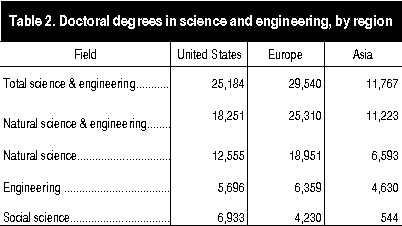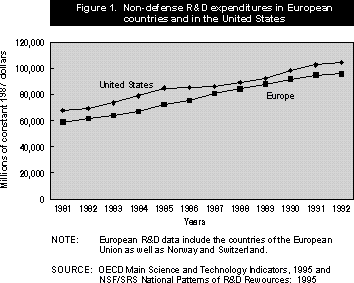|
 |
First university degrees in NS&E fields awarded by institutions in Western and Central Europe totaled almost 300,000 in 1992, compared to 173,000 awarded by U.S. universities and colleges in that year.
Table 1 shows that the European and U.S. regions would have to combine their potential human resources for science and engineering (B.S. degrees) to match those of the Asian region.
Relative to population, Western and Central European institutions are not producing more NS&E degrees than those in the United States. In 1992, 4.6 percent of the college-age cohort in the United States received an NS&E degree, compared to 4.0
percent of the European college-age population. Many European institutions' first university degrees, however, are for 6-year programs and therefore may be more comparable with a combined bachelor's and master's degree in the United States.
In addition, European and Asian institutions award a higher percentage of all their undergraduate degrees in NS&E fields than U.S. universities and colleges. About 30 percent of first university degrees awarded by institutions in EU countries are in
the natural sciences and in engineering; about 15 percent of U.S. degrees are in those fields.
In 1992, doctoral degrees awarded in NS&E fields by Western and Central European institutions totaled more than 25,000, 38 percent above the U.S. level, and more than twice as many as the number recorded for Asian countries (see table 2). Like the United States, a large percentage of European doctoral degrees are earned by foreign students. For example, almost 50 percent of the degrees awarded in the United Kingdom in engineering and almost 35 percent of
those awarded by French universities in the natural sciences are earned by foreign students. This high degree of foreign participation is partially attributable to the long-standing tradition of educating students from former colonial territories.
|


